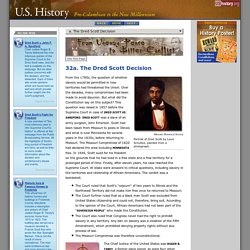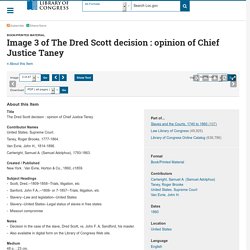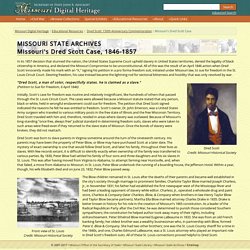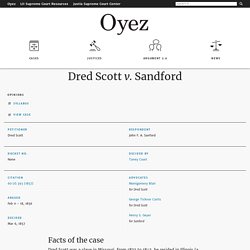

The Dred Scott Decision. Missouri Historical Society Portrait of Dred Scott by Louis Schultze, painted from a photograph.

From the 1780s, the question of whether slavery would be permitted in new territories had threatened the Union. Over the decades, many compromises had been made to avoid disunion. But what did the Constitution say on this subject? This question was raised in 1857 before the Supreme Court in case of Dred Scott vs. The Court ruled that Scott's "sojourn" of two years to Illinois and the Northwest Territory did not make him free once he returned to Missouri.The Court further ruled that as a black man Scott was excluded from United States citizenship and could not, therefore, bring suit. Dred Scott's battle for his freedom began at the Old Courthouse in St. Image 3 of The Dred Scott decision : opinion of Chief Justice Taney. Citations are generated automatically from bibliographic data as a convenience, and may not be complete or accurate.

Chicago citation style: United States Supreme Court, Roger Brooke Taney, John H Van Evrie, and Samuel A Cartwright. The Dred Scott decision: opinion of Chief Justice Taney. New York: Van Evrie, Horton & Co., 1860, 1860. Pdf. APA citation style: Dred Scott. Dred Scott first went to trial to sue for his freedom in 1847.

Ten years later, after a decade of appeals and court reversals, his case was finally brought before the United States Supreme Court. In what is perhaps the most infamous case in its history, the court decided that all people of African ancestry -- slaves as well as those who were free -- could never become citizens of the United States and therefore could not sue in federal court. The court also ruled that the federal government did not have the power to prohibit slavery in its territories.
Scott, needless to say, remained a slave. Born around 1800, Scott migrated westward with his master, Peter Blow. Scott's extended stay in Illinois, a free state, gave him the legal standing to make a claim for freedom, as did his extended stay in Wisconsin, where slavery was also prohibited. Scott went to trial in June of 1847, but lost on a technicality -- he couldn't prove that he and Harriet were owned by Emerson's widow.
Dred Scott Case - Black History. This convoluted case (1857), both a cause and an effect of sectional conflict, contributed to antebellum political and constitutional controversy.

It also made Chief Justice Roger B. Taney seem a satanic figure to contemporary antislavery activists and many later historians. Who Was Dred Scott? Dred Scott, a black slave, and his wife had once belonged to army surgeon John Emerson, who had bought him from the Peter Blow family of St. Louis. Because Mrs. Dred Scott v. Sandford: Primary Documents of American History (Virtual Programs & Services, Library of Congress) Library of Congress Web Site | External Web Sites | Selected Bibliography Abraham Lincoln Papers at the Library of Congress The complete Abraham Lincoln Papers at the Library of Congress consists of approximately 20,000 documents.

Abraham Lincoln, [December 1856] (Speech Fragment on Dred Scott Case) The Frederick Douglass Papers at the Library of Congress The online collection, containing approximately 7,400 items, spans the years 1841-1964, with the bulk of the material dating from 1862 to 1865. Slaves and the Courts, 1740-1860 This collection contains just over a hundred pamphlets and books (published between 1772 and 1889) concerning the difficult and troubling experiences of African and African-American slaves in the American colonies and the United States. Words and Deeds in American History From Slavery to Freedom: The African-American Pamphlet Collection, 1824-1909 Chronicling America. Missouri Digital Heritage: Dred Scott Case, 1846-1857.
In its 1857 decision that stunned the nation, the United States Supreme Court upheld slavery in United States territories, denied the legality of black citizenship in America, and declared the Missouri Compromise to be unconstitutional.

All of this was the result of an April 1846 action when Dred Scott innocently made his mark with an "X," signing his petition in a pro forma freedom suit, initiated under Missouri law, to sue for freedom in the St. Louis Circuit Court. Desiring freedom, his case instead became the lightning rod for sectional bitterness and hostility that was only resolved by war. Dred ScottCredit: Missouri Historical Society "Dred Scott, a man of color, respectfully states. he is claimed as a slave. " Initially, Scott's case for freedom was routine and relatively insignificant, like hundreds of others that passed through the St. Dred Scott v. Sandford. The majority held that “a negro, whose ancestors were imported into [the U.S.], and sold as slaves,” whether enslaved or free, could not be an American citizen and therefore did not have standing to sue in federal court.

Because the Court lacked jurisdiction, Taney dismissed the case on procedural grounds. Taney further held that the Missouri Compromise of 1820 was unconstitutional and foreclose Congress from freeing slaves within Federal territories. The opinion showed deference to the Missouri courts, which held that moving to a free state did not render Scott emancipated. Finally, Taney ruled that slaves were property under the Fifth Amendment, and that any law that would deprive a slave owner of that property was unconstitutional. In dissent, Benjamin Robbins Curtis criticized Taney for addressing the claim’s substance after finding the Court lacked jurisdiction.